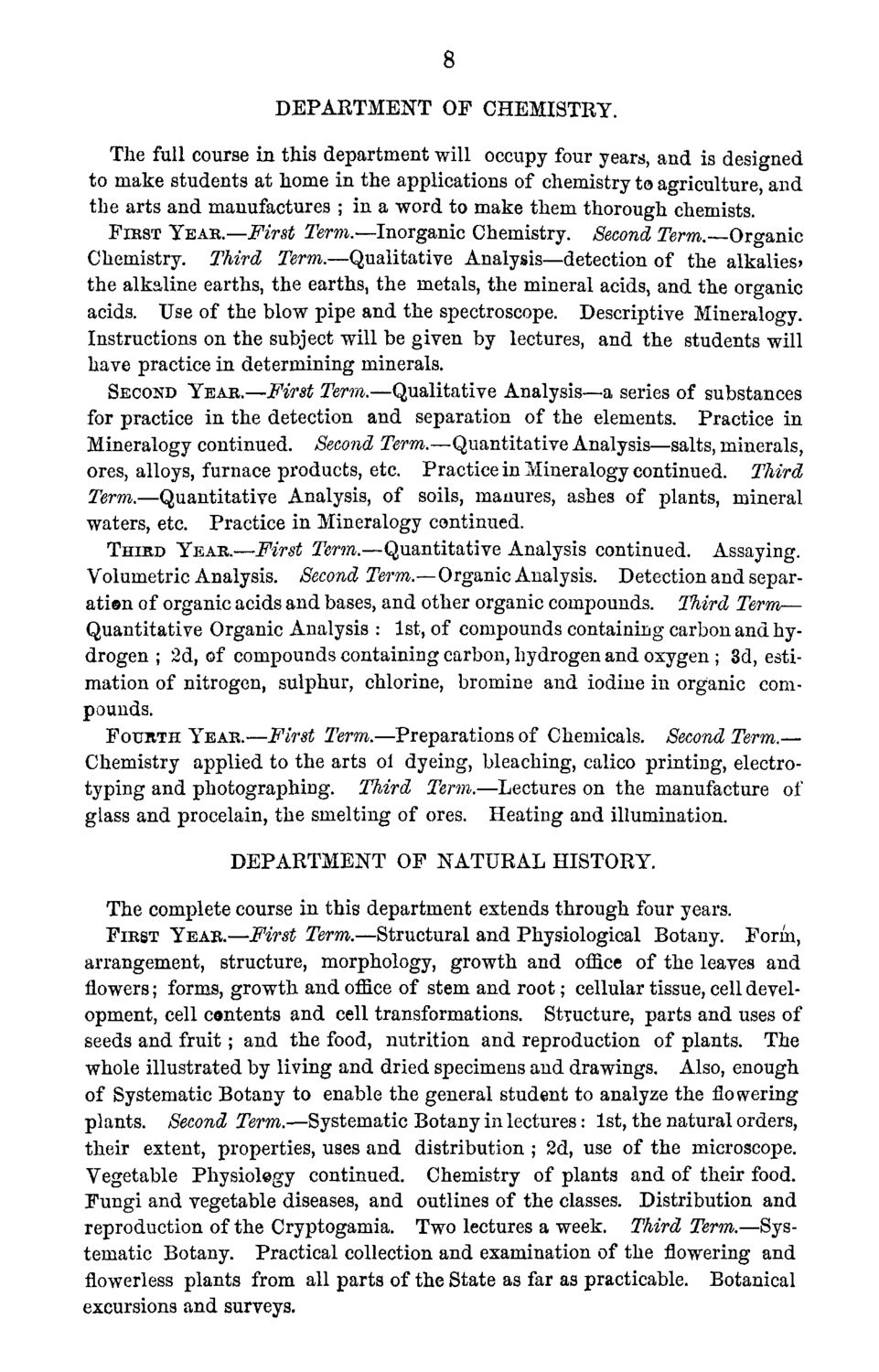| |
| |
Caption: Course Catalog - 1868-1869 VERSION A
This is a reduced-resolution page image for fast online browsing.

EXTRACTED TEXT FROM PAGE:
DEPARTMENT OF CHEMISTRY. The full course in this department will occupy four years, and is designed to make students at home in the applications of chemistry ts agriculture, and the arts and manufactures ; in a word to make them thorough chemists. FIRST YEAR.—First Term.—Inorganic Chemistry. Second Term. Organic Chemistry. Third Term.—Qualitative Analysis—detection of the alkalies; the alkaline earths, the earths, the metals, the mineral acids, and the organic acids. Use of the blow pipe and the spectroscope. Descriptive Mineralogy. Instructions on the subject will be given by lectures, and the students will have practice in determining minerals. SECOND YEAR.—First Term.—Qualitative Analysis—a series of substances for practice in the detection and separation of the elements. Practice in Mineralogy continued. Second Term.—Quantitative Analysis—salts, minerals, ores, alloys, furnace products, etc. Practice in Mineralogy continued. Third Term.—Quantitative Analysis, of soils, manures, ashes of plants, mineral waters, etc. Practice in Mineralogy continued. THIRD YEAR.—First Term.—Quantitative Analysis continued. Assaying. Volumetric Analysis. Second Term.—Organic Analysis. Detection and separatisn of organic acids and bases, and other organic compounds. Third Term— Quantitative Organic Analysis : 1st, of compounds containing carbon and hydrogen ; 2d, of compounds containing carbon, hydrogen and oxygen ; 3d, estimation of nitrogen, sulphur, chlorine, bromine and iodine in organic compounds. FOURTH YEAR.—First Term.—Preparations of Chemicals. Second Term.— Chemistry applied to the arts ol dyeing, bleaching, calico printing, electrotyping and photographing. Third Term.—Lectures on the manufacture of glass and procelain, the smelting of ores. Heating and illumination. DEPARTMENT OF NATURAL HISTORY. The complete course in this department extends through four years. FIRST YEAR.—First Term.—Structural and Physiological Botany. Forin, arrangement, structure, morphology, growth and office of the leaves and flowers; forms, growth and office of stem and root; cellular tissue, cell development, cell contents and cell transformations. Structure, parts and uses of seeds and fruit; and the food, nutrition and reproduction of plants. The whole illustrated by living and dried specimens and drawings. Also, enough of Systematic Botany to enable the general student to analyze the flowering plants. Second Term.—Systematic Botany in lectures: 1st, the natural orders, their extent, properties, uses and distribution ; 2d, use of the microscope. Vegetable Physiolegy continued. Chemistry of plants and of their food. Fungi and vegetable diseases, and outlines of the classes. Distribution and reproduction of the Cryptogamia. Two lectures a week. Third Term.—Systematic Botany. Practical collection and examination of the flowering and flowerless plants from all parts of the State as far as practicable. Botanical excursions and surveys.
| |